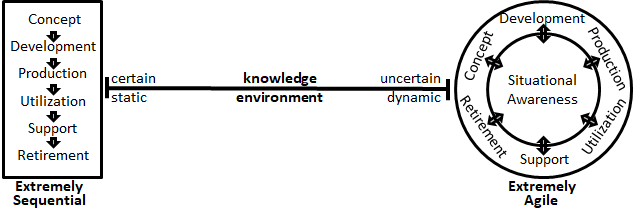Life Cycle Concepts: Difference between revisions
No edit summary |
|||
| Line 7: | Line 7: | ||
A life cycle is the evolution of a system, product, service, project or other human-made entity from conception through retirement. (ISO/IEC/IEEE 24748-1:2024) | A life cycle is the evolution of a system, product, service, project or other human-made entity from conception through retirement. (ISO/IEC/IEEE 24748-1:2024) | ||
It can be helpful to create models to depict and manage the progression of an entity from beginning to end. These models are called life cycle models. A life cycle model is a framework of processes and activities concerned with the life cycle which can be organized into stages, acting as a common reference for communication and understanding | It can be helpful to create models to depict and manage the progression of an entity from beginning to end. These models are called life cycle models. A life cycle model is a framework of processes and activities concerned with the life cycle which can be organized into stages, acting as a common reference for communication and understanding (ISO/IEC/IEEE 24748-1:2024) See “Knowledge Area – [[Life Cycle Model Selection and Adaptation]]” for further elaboration. | ||
A stage is a period within the life cycle of an entity that relates to the state of its description or realization. Stages relate to major progress, achievement milestones, or decision points of the entity through its life cycle. Stages often overlap. | A stage is a period within the life cycle of an entity that relates to the state of its description or realization. Stages relate to major progress, achievement milestones, or decision points of the entity through its life cycle. Stages often overlap. (ISO/IEC/IEEE 24748-1:2024) See “Article – [[Life Cycle Stages]]” for more information about stages, including entry and exit criteria for progressing between stages, and “Article – [[Technical Reviews and Audits]]” for assessing progress within stages. | ||
Figure 1 shows a spectrum of life cycle approaches, depending on the level of uncertainty. All life cycle approaches fall somewhere between the two ends of the spectrum, with neither end of the spectrum being common in practice. | Figure 1 shows a spectrum of life cycle approaches, depending on the level of uncertainty. All life cycle approaches fall somewhere between the two ends of the spectrum, with neither end of the spectrum being common in practice. | ||
[[File:LC Spectrum.png|alt=|center|thumb|644x644px|'''Figure 1. SE life cycle spectrum.''' (Dove, 2022. Used with permission. All other rights reserved.)]] | [[File:LC Spectrum.png|alt=|center|thumb|644x644px|'''Figure 1. SE life cycle spectrum.''' (Dove, 2022. Used with permission. All other rights reserved.)]] | ||
Revision as of 23:42, 18 May 2025
Lead Authors: Mike Yokell Contributing Authors: David Endler, Garry Roedler
A life cycle is the evolution of a system, product, service, project or other human-made entity from conception through retirement. (ISO/IEC/IEEE 24748-1:2024) A stage is a period within the life cycle of an entity that relates to the state of its description or realization. Stages relate to major progress, achievement milestones, or decision points of the entity through its life cycle. It can be helpful to create models to depict and manage the progression from beginning to end. These models are called life cycle models.
Basic terms and concepts
A life cycle is the evolution of a system, product, service, project or other human-made entity from conception through retirement. (ISO/IEC/IEEE 24748-1:2024)
It can be helpful to create models to depict and manage the progression of an entity from beginning to end. These models are called life cycle models. A life cycle model is a framework of processes and activities concerned with the life cycle which can be organized into stages, acting as a common reference for communication and understanding (ISO/IEC/IEEE 24748-1:2024) See “Knowledge Area – Life Cycle Model Selection and Adaptation” for further elaboration.
A stage is a period within the life cycle of an entity that relates to the state of its description or realization. Stages relate to major progress, achievement milestones, or decision points of the entity through its life cycle. Stages often overlap. (ISO/IEC/IEEE 24748-1:2024) See “Article – Life Cycle Stages” for more information about stages, including entry and exit criteria for progressing between stages, and “Article – Technical Reviews and Audits” for assessing progress within stages.
Figure 1 shows a spectrum of life cycle approaches, depending on the level of uncertainty. All life cycle approaches fall somewhere between the two ends of the spectrum, with neither end of the spectrum being common in practice.
References
Works Cited
SE Handbook Chapter 2.1.1 and 4.2.2
ISO/IEC/IEEE 24748-1. 2024. Systems and software engineering — Life cycle management, Part 1: Guidelines for life cycle management. Geneva, Switzerland: International Organization for Standardization (ISO), International Electrotechnical Commission, and Institute of Electrical and Electronics Engineers.
Primary References
None.
Additional References
None.
